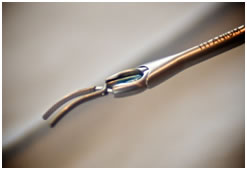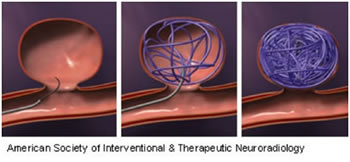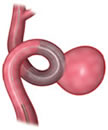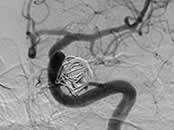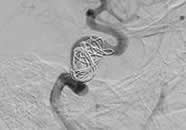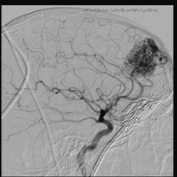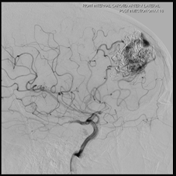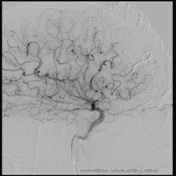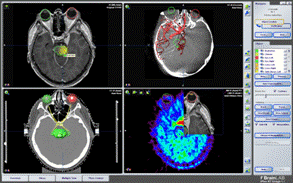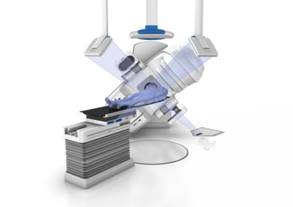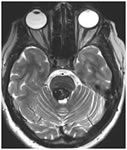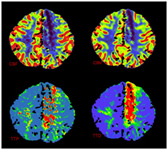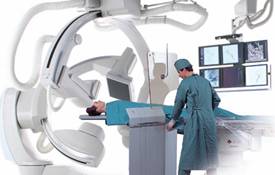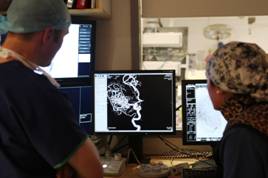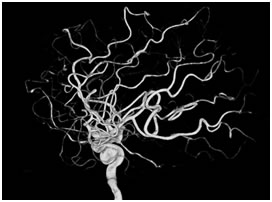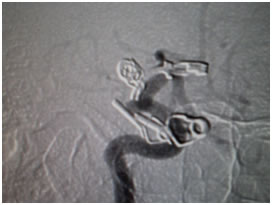 |
|
   |
|
| Home » Services » Blood Vessel Conditions | |||||||||||||||||
AneurysmsAneurysms are an out-pouching of an arterial wall that represents a weak point. They are found in about 2-3% of the population and are usually silent until they rupture. A ruptured aneurysm usually presents with the worst headache ever and rapid onset of neurological problems. The hallmark pattern of haemorrhage is called "Subarachnoid haemorrhage".
The typical haemorrhage pattern seen following aneurysm rupture. The shape and location of the aneurysm may predict its behaviour and also determine which treatment option is likely to be best. Alternatively, if the aneurysm represents a low risk of rupture or a high surgical risk, we may elect to follow it with serial imaging. Intervention is designed to stop blood flow into the aneurysm, thereby eliminating the risk of haemorrhage. It can be done remotely by filling the aneurysm from within (endovascular "coiling"), or by open microsurgical techniques ("clipping"). Surgical Clipping A small incision is made behind the hairline and a piece of bone removed to allow access to the aneurysm. The aneurysm is identified, with its branches and one or more clips applied externally to its neck. Sometimes, I will perform an angiogram at this time to ensure that all the branches are filling normally. When the aneurysm is cured, the bone is replaced with special titanium plates and the incision closed.
Coiling & Embolisation Coiling is performed under general anaesthetic, and a small, flexible tube is placed inside the aneurysm. Through this, a series of soft platinum coils are deposited within the aneurysm sac leading to complete thrombosis. Various stents and balloons have permitted a much greater range and shape of aneurysms to be successfully treated. The newest development in the endovascular treatment of aneurysm is "flow-diversion". In some large aneurysms, it has revolutionised treatment through simplicity and effectiveness.
Arteriovenous Malformations (AVMs)Arteriovenous Malformations or AVMs are congenital abnormalities affecting the blood vessels of a specific region of the brain. They result from an interruption of the normal and progressive sequence of blood vessel wall type from artery to capillary to vein. Instead of this sequential change, a nidus or tangle of vessels under arterial pressure exists, which shunts blood directly from the high pressure arterial circulation to the venous circulation, with no slowing down and little downgrade in pressure. The result is constant high flows and elevated pressure throughout the AVM. This places abnormal shear stress on the vessels and can lead to vessel wall rupture and spontaneous haemorrhage. In addition to the local consequences of high flow and elevated venous pressures, the nearby brain is effectively starved of its blood flow. This is particularly so with large AVMs and may result in what is referred to as a "steal" syndrome. This can cause neurological problems, if the nearby brain is functionally important or "eloquent". Arteriovenous malformations can present with spontaneous haemorrhage, seizures, a neurological problem or deficit, or headaches. With CT and MRI scanning much more prevalent now, they may also be found incidentally. Management decisions are based on balancing the estimated risk of immediate and future haemorrhage ("the cumulative life-time risk) versus the risk of eradicating the lesion with treatment. Of course, despite the use of complex tables and statistical methods, it is not possible to know with certainty the natural history for any individual. Most people quote that the annual risk of haemorrhage associated with an AVM is between 2 and 4%. Certain risk factors exist which may increase this likelihood including prior haemorrhage, feeding artery or intranidal aneurysms, restricted venous outflow and underlying respiratory or medical conditions. Each haemorrhage also carries the possibility of death or stroke and disability. A number of imaging modalities may be used to define the AVM. CT and its variant "CTA" provides information on location and static vascular anatomy including which vessels are supplying and draining the AVM. MRI tells us where in the brain the AVM lies and helps gauge surgical risk and approaches and gives information about prior haemorrhages. Cerebral angiography or "DSA" gives detailed dynamic information on flow patterns and venous drainage. It is the most sensitive and powerful test, however it is technically more "invasive" and carries a very small risk of stroke with it. Treatment recommendations may range from observation and medication only to microsurgical excision, but other forms of treatment are becoming more prominent globally. Blocking the arterial feeders internally, through the artery is called "embolization" and this is extremely helpful in making surgery safer. It is usually a preoperative maneuver. Occasionally, it may be the only treatment required. Onyx Embolization
Arteriovenous malformations may also be cured with "radiosurgery". This modality involves using powerful computers to direct an arrangement of radiation rays toward the AVM volume. AVM shapes are often complex and a great deal of planning is needed in the targeting. This form of treatment does not have its effect immediately, and results in the slow obliteration of flow within the AVM over several years. Of low volume lesions that are treated, between 70 to 85% will be cured. Progress MRIs and angiograms are needed to establish cure. 3cm lesions used to be the upper limit in size of targeted lesions, but it may be possible to treat larger lesions if the "marginal" dose – that given to the edge of the lesion is lowered. The correct marginal dose is needed to get the best balance between lesion cure and brain protection. In many cases, especially large and symptomatic AVMs, multi-modality treatment using more than one form of intervention will be the safest way to give the best outcome.
Cavernous MalformationsCavernous malformations are focal collections of dilated, thin walled vessels under low pressure and with low flow. There is usually evidence of previous haemorrhage in or around the lesion and they have a very characteristic MRI appearance. Familial forms occur and they may be solitary or multiple. They may present with seizures, neurological events, haemorrhage, or they may be found as an incidental finding. Those lesions not causing symptoms are observed with MRI. Accessible, symptomatic malformations are removed.
Moya Moya DiseaseThis is a poorly understood disease of the major arteries at the base of the brain. Progressive narrowing is seen in the large arteries and in response to this, a network of fine vessels form in an attempt to maintain blood supply to the starved brain. The condition presents with TIAs or ischaemia, or with intracerebral haemorrhage. The definitive diagnosis is made with cerebral angiography. The treatment consists of range of strategies from observation to extracranial - intracranial (EC-IC) bypass surgery. Endovascular treatments are not usually recommended because of vessel fragility and restenosis. Additionally some relatively simple procedures may improve blood flow and help with symptoms. Cerebral AngiographyA cerebral angiogram is a combined surgical and radiological procedure, performed in order to better define abnormalities of the blood vessels supplying the brain and its coverings. It is the gold standard investigation for identifying and describing conditions such as aneurysms, arteriovenous malformations, stroke and other blood vessel abnormalities. It can also be helpful for large tumours, which can move important vessels from their usual position and also flow patterns. It uses X-ray technology to reconstruct illuminated blood vessels.
A new high resolution Toshiba Biplane device at the North Shore Private Hospital enables unrivalled detail to be extracted about the shape, size and adjacent branch anatomy of aneurysms, as well as flow patterns and arterial and venous anatomy of an AVM (arteriovenous malformation). This information is critical for safe treatment planning. In addition, when it comes to small lesions, cerebral angiography is the only test that can reliably differentiate between a harmless infundibulum (a normal developmental variant) and a true saccular aneurysm. It is also the best test to use when looking at stented arteries and previously clipped regions.
|
|||||||||||||||||
 |
© Dr Jonathan Curtis MBBS, FRACS, Neurosurgeon, Spine and Endovascular Greenwich NSW |
|
| Home | Disclaimer | Privacy | Sitemap | Feedback | Tell a friend | Contact Us |
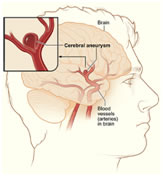
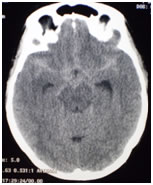 It may also cause instant death or lead to permanent disability. In some cases, there is a strong family history or a genetic condition. The most common inherited condition is adult polycystic kidney disease. Risk factors for aneurysm rupture include smoking, poorly controlled hypertension, and excessive straining. If untreated, there is a cumulative annual risk of rupture and regular surveillance is recommended.
It may also cause instant death or lead to permanent disability. In some cases, there is a strong family history or a genetic condition. The most common inherited condition is adult polycystic kidney disease. Risk factors for aneurysm rupture include smoking, poorly controlled hypertension, and excessive straining. If untreated, there is a cumulative annual risk of rupture and regular surveillance is recommended.